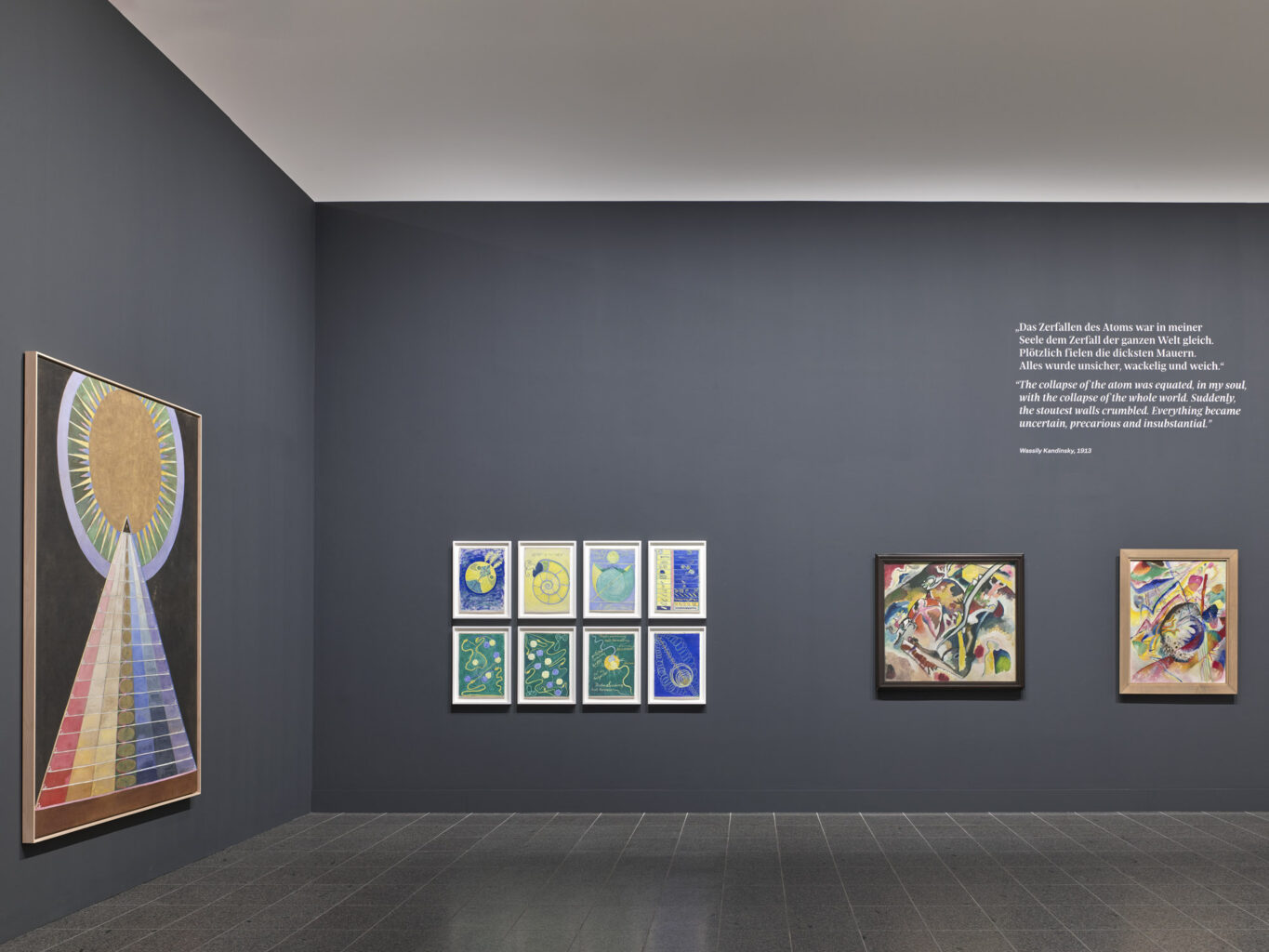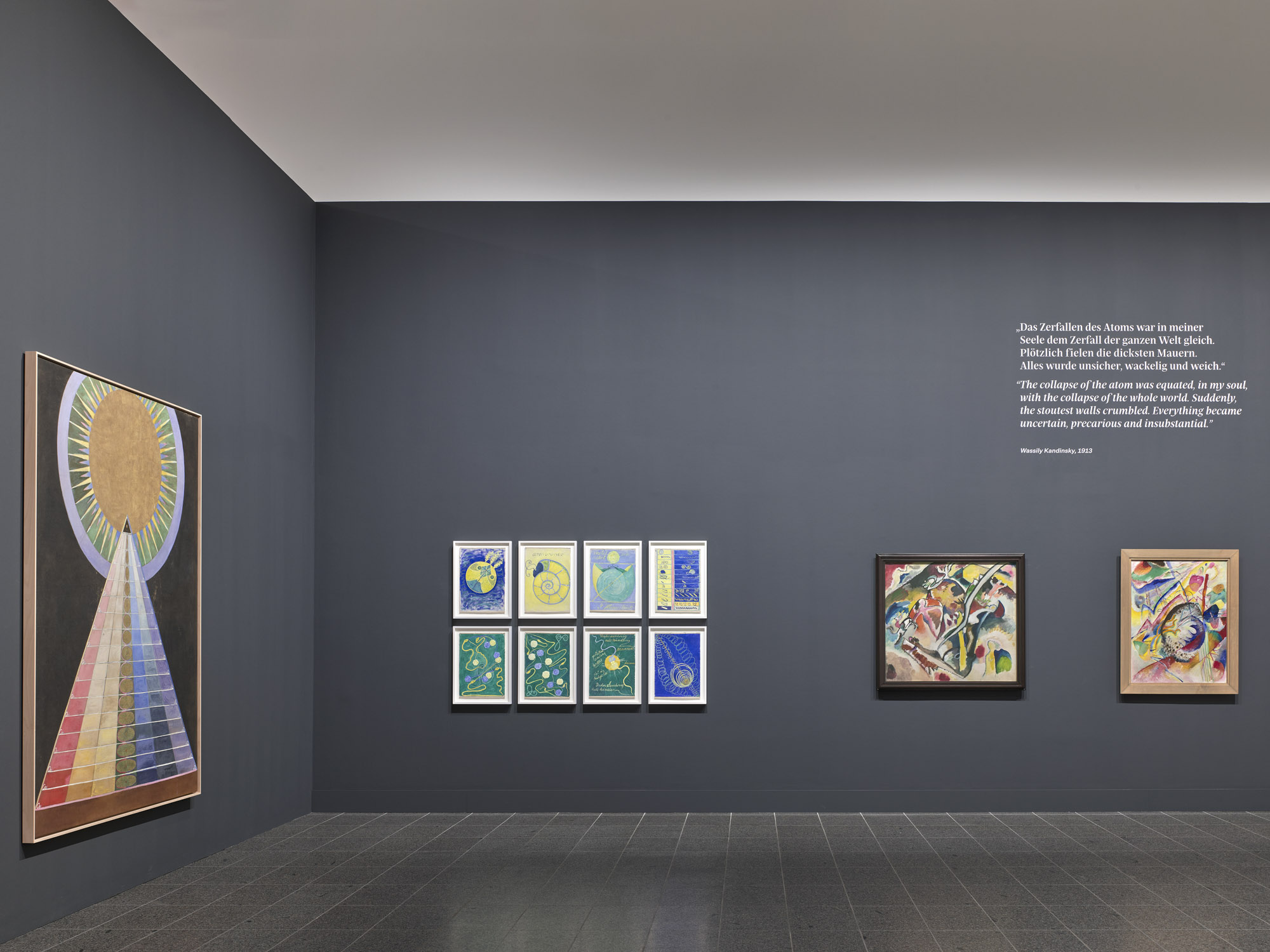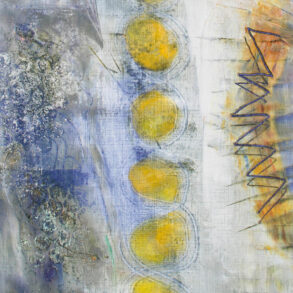Dreams of the Future is a new exhibition juxtaposing Hilma af Klint and Wassily Kandinsky—it is open at the Kunstsammlung Nordrhein-Westfalen in Düsseldorf, Germany, until August 11, 2024.
Wassily Kandinsky is regarded as the pioneer of abstract painting. But, when Hilma af Klint’s work became known at the end of the twentieth century, and even more so at the beginning of the twenty-first century, it was realised with astonishment that her large abstract paintings had been created in 1907, three years before Kandinsky’s step into abstraction. That being said, the question of who painted the first abstract picture is not in debate at this exhibition. Instead, the exhibition is about spirituality and the two artists’ surprisingly parallel development.
Just like their difference in age (af Klint was born in 1862, Kandinsky 1866), their step into abstraction was also separated by four years—1906 and 1910 respectively. There are other interesting things that occurred simultaneously, including their relationship with Rudolf Steiner. The large chronological chart in the entrance to the exhibition lists under 1908: af Klint listens to Rudolf Steiner’s lectures in Stockholm, Kandinsky in Munich. They were both concerned with finding appropriate forms of expression for an expanded experience of reality. Abstraction was not a value in and of itself. Only when abstraction became well known in post-revolutionary Russia did Kandinsky claim that priority. Apart from that, however, the exhibition makes it possible to perceive the almost irreconcilable differences between the two approaches. Unease arises again and again: Kandinsky’s paintings (even his large ones) appear small, fussy and confused next to af Klint’s amply painted pictures with their bright colours; and reciprocally, af Klint’s paintings are eye-catching and appear as if they were simply painted loosely and cheerfully, next to Kandinsky’s careful, delicate, and thoroughly worked out pieces. Every artistic approach requires a view appropriate to it, and so it goes in this case.
On display are af Klint’s complete cycle from 1907: “The Ten Largest” (so-called, but actually her largest paintings measure 10.5 x 7.75 ft [320 x 240 cm]), supplemented by smaller cycles from the 1910s, and Kandinsky’s three large key works from 1911, 1923, and 1939, from his own collection and numerous others, some of which are from remote provenance.
Out of the World of Objects
The transitions on Kandinsky’s path to abstraction are not the theme of the exhibition. A few examples from Murnau 1908 are directly followed by so-called “Improvisations” from 1910 and 1911, which do not yet wholly abandon objects, but which no longer have a model present in the external world. However, the collaboration between the two stages of development becomes all the clearer: colourful strokes and smudges of concentrated force that have a tendency to tear themselves away from the tracing of a finished “given.”1 Kandinsky’s pictorial devices take on a life of their own. His colour develops a dynamic that tears apart the layer of the depictive mode of representation and opens a free view into a world beyond three-dimensional space. Colour shows its own original, inherent potency, which becomes noticeable in the shape of Kandinsky’s typical smudges as a pushing and shoving. Hence his tendency towards fine partitioning and chaos, which really stands out next to af Klint’s pictures, only to again disappear from the foreground of perception as soon as we discover that the parts of the pictures are related to one another through balance. Each of the many elements finds its place by balancing out the weights of the other elements. The picture becomes a cosmos of dynamically interrelated elements, which also frees us as observers from our captivity in the coagulated forms of objects and shifts us into a state of creativity. Kandinsky’s way out of the world of objects becomes one’s own experience.

Changing Identity
With af Klint’s paintings, we find something entirely different. Her pictures are alienating; they lack the sublime balance of Kandinsky and their other contemporaries. They appear as a play with forms—with circles, spirals, and ornate lines—which also sit securely on the surface like objects, having been sketched out beforehand and painted in luminescent pastel tones. It is not surprising that friends were able to help with the painting once the form had been traced and the colour tone specified. Were these pictures meant to be nothing more than serene decorations or encrypted representations of an unknown content? Although, when one notices that the parts are also bound together with one another, then the pictures open up. We find here a fundamental similarity of the elements, yet there is also a disparity. Two circles next to one another, one orange, the other indigo, connected by an overlapping zone in greenish gold; above, another circle with flower forms in pink and, next to this, ellipses arranged around a small centre, also filled-in differently than the others. Always a circle, but not the same. We note an identity, which is repeated but receives a new accent. The horizontal juxtaposition often shows contrasts, while the upward direction has to do with transformation. Naturally, such a succession of perceptions is unavoidable, but it takes on an unexpected function.
With Kandinsky, there is an experience of gaining an overview, from which the interwovenness of the whole becomes perceptible. With af Klint, in contrast, the essential is already touched with each individual step. In the “Ten Largest,” this experience is intensified through the alternation of coloured backgrounds. The series begins with two blues, one deep and one lighter (the above description of circles applies to this second painting), followed by two oranges and, subsequently, a violet, gradually lightening, until it is replaced by a pink, and then another pink that nearly evaporates entirely. Not only within the individual pictures, but also in the succession of the sequence, an interplay of identity and transformation is evident. The serenity of each picture obtains its own mood, which is taken up by the configuration of the forms and, in each case, is implemented in a wholly different dynamic. So, for example, the fifth picture appears to be a purely tuned climax, preceded by the hopeful beginning of the blue pictures and the pioneering spirit of the orange pictures, to then be followed by new structuring elements, together with a dynamic that reaches downwards again, flowing out in separations and finding its close in processes of crystallisation. We experience the theme of evolution and, more precisely, the theme of the ages of childhood, youth, adulthood, and old age. We can imagine the ten seven-year periods of life. But, introducing preconceived ideas eventually falls through. One can see that, over the years, the abundance of constellations will continue to open up as the pictures become essential companions with one another.
Beyond the Sensation of the Body
The geometric simplicity of the elements warranting the experience of identity—the circles, ellipses, and their variations—ensures that this experiential path plays out at cosmic heights and beyond our bodily experience. We do not feel ourselves raised up, as with Kandinsky, but rather enraptured, which is not surprising in view of the genesis of the paintings. Against the background of her many years of mediumistic experience, af Klint regarded herself only as an instrument of higher beings, known to her by name, who guided her hand and placed ideas within her. The musical attunement of the pictures belongs to this, which became especially clear to me through the contrast with examples by another hand. The starting points of Kandinsky and af Klint lie far distant from one another. Kandinsky works his way out of objectivity and thereby reaches a level where the whole determines the individual parts. Af Klint, in contrast, brings her forms down from out of a sphere in which the corporeal plays no role at all, where, freed from the body, we feel ourselves addressed in the changing orientation of the sensation of identity. Coming from polar directions, both search for forms of expression of the spirit and find them in abstraction.
Steiner, Kandinsky, af Klint
However, neither is concerned with the effectivity of the spirit in the sensible—artistically speaking; neither is concerned with shape formation itself. This is the fundamental thought of anthroposophy, with its concern for bringing inspiration all the way into concrete modes of activity. In regards to colour, this also involves a process of freeing it, not only from its being bound to objects but also from its adherence to smudges or otherwise, which may be imagined along with it. Instead of pushing, it can now begin to stream, and out of this flow, it figures itself anew.
Only by also including this approach do we see the multilayeredness of the situation at the time. But, this idea was hardly noticed in the period around 1910. For Kandinsky, it was important to find a confirmation of the reality of the spirit with Steiner, and af Klint hoped for a clarifying conversation. She sought an understanding of her paintings, which had all arisen in an enormous inward flood. After completing them, she took a four-year break. During this time, Steiner “made a detailed explanation” of her work.2 One would like to know what was discussed and whether metamorphosis was mentioned! In any case, af Klint’s further works also show an interplay of similarity and difference, but they took on a much stricter, almost ascetic character. Colour hardly played a role any more. Only in 1922 did she return to it, when she began to work in watercolour (not shown in the exhibition but thoroughly documented in a catalogue available in the museum shop). The small works show colourful clouds out of which mainly bright, recessed figures emerge. Some are reminiscent of the late Odilon Redon, others of Steiner. She actually became a member of the Anthroposophical Society in 1920 and often spent several months a year in Dornach until 1930. The severity of the drawn form disappears. A new breathing begins—a cautious, probing openness, in which the higher sphere is still traceable as her homeland.
I personally had difficulty with af Klint’s works from the 1910s. But seeing “The Ten Largest” in the original should not be missed by anyone who can get there!
Translation Joshua Kelberman
Footnotes
- “Given” in the philosophical sense of what is directly presented to consciousness, the object of the act of perception.
- See the interview with Anne Weise: “Hilma af Klint’s Relationship with Anthroposophy,” the Goetheanum Weekly (May 26, 2023).









